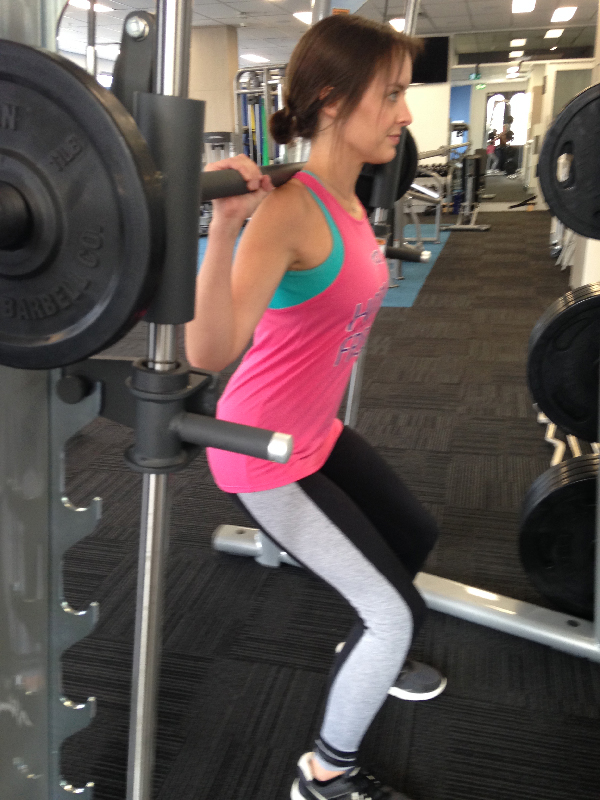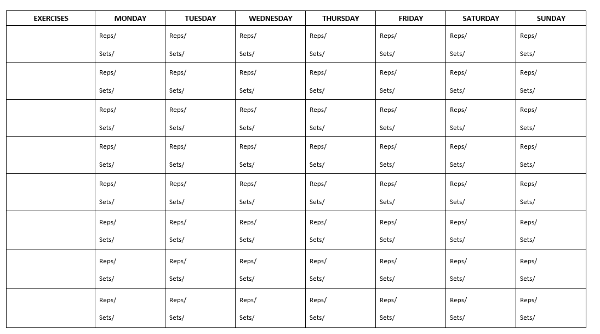Strength training: 7 great tips for building a stronger you!

Strength training is useful to maintain or improve your health at any age . Not only does weight bearing exercise help us build strength and muscle mass. Strength training also helps maintain and strengthen bone density. When starting strength training for the first time, after injury or after some time off, remember to start gradually.
If you are eager to start to increase your strength through strength training, a chat with your local exercise professional or physiotherapist will get you started on the right foot. Below are some great tips to keep in mind when getting started.
1. Get advice
To train properly it is best to get advice. Particularly when starting out, understanding how you can meet your goals and what you should be fueling your body with for training is important. Weight training is only a small part of training. Diet is a very important element. Refueling the body with appropriate balance of macro-nutrients (carbohydrates, proteins and fats). Carbohydrates are the fuel that our muscles use to function. Protein is what muscle is made of and following training is needed to help rebuild the muscle.
For some good advice regarding diet and training the Australian Institute of Sport and the Australian National Health and Medical Research Council have useful information regarding appropriate diet.
2. Set goals

Setting goals is important to keep motivated. To set appropriate goals you need to set SMART goals. Specific, Measurable, Achievable, Realistic and Time-based. It is good when training to set an end goal and smaller more manageable goals that work towards the end goal.
Goals help guide the process of strength training and how to structure your training regime. For instance, are you a runner who wants to add some strength training into your regime? Are you just de-conditioned and want to increase your over-all strength? Are you wanting to be the next big thing in body building?
All these are very different forms of exercise and the training style should be completely different. You may include similar exercises but the frequency of the exercises and the effort put into each exercise will differ depending on your goals.
An example of an unrealistic goal would be to start lifting weights to lose weight on the scales. This is unrealistic because lifting increases muscle.
3. Know when and why you are lifting.
The human body cannot handle lifting maximal weight continuously. This is a fast way to injury yourself. To help build strength, evidence shows frequency of strength training to get a muscle building effect and targeting a muscle group every 48 – 72 hours is all that is necessary. It is also not necessary to aim for a personal best lift each time you train. Maintenance of muscle strength will occur performing a sub-maximal lift. Not lifting a PB each time also allows your body to recover reducing injury risk. How much weight you lift should be determined by how you feel from day to day.
The repetitions and sets of weights you lift changes the overall effect is has on your body. There is some overlap in the benefit of different methods of weight lifting. When weight training it is important that you train your body at a rate that is fatiguing. Once you have chosen you training style you need to ensure you gently fatigue your body with each workout.

Strength
To just develop strength without increasing muscle bulk training should involve lifting with 1-8 repetitions, 1 to 8 sets with 30 seconds to several minutes rest in-between sets.
Muscle mass
It has been shown that training to develop muscle mass is best achieved by lifting between 8-12 repetitions and 3 – 5 sets and only requiring approximately 30 seconds to several minutes rest in-between sets.
Endurance
Endurance training is sub-maximal training however this does not mean people do not need to train without weight. Try 12 plus repetitions, lots of sets, short rest.
Power
Power training is explosive movement training. Developing the body’s ability to recruit muscle fibres quickly. Training aims to increase your power which involves lifting with speed of 1-8 repetitions, 1 to 8 sets with complete rest in-between each set. Weight training like this requires a good understanding of the lift. Training is normally sub-maximal loads performed with speed or short duration of lifting time. Power exercise comes with a high risk of injury and should not be a way someone starts training.
Training methods
As well as picking appropriate repetitions needed to meet your goals. A combination of the different muscle activation methods is also very useful to minimize injury and assist in development of muscle strength.
There are three ways our muscle is activated: isometrically, concentrically and eccentrically. Isometric activation is where the muscle contracts without lengthening or shortening it is just a sustained activation or the muscle. A concentric contraction is when the muscle is shortening while contracting i.e as you lift your hand up to your shoulder bending you elbow, your biceps are shortening. An eccentric contraction is when a muscle sustains its contraction while the muscle is lengthened out i.e the biceps is lengthening as we gradual straighten our elbow while muscle tension is sustained.
Isometric training is healthy for minimising stress on our body. Eccentric loading helps develop muscle bulk at a greater rate. Concentric training is a common action our body performs during a lot of sporting movements.
A good balanced program should incorporate exercises that involve these different types of loading.
4. Exercise Diary

Keeping a diary is also important to see your progress and to help measure performance. Keeping in mind when training, a body will not always be able to train at 100%. Using a diary helps you see your own bodies cycles and when it is best for you to train.
5. Technique and control
As a physio, a big reason I see people for injuries related to the strength / weight training is usually poor technique or lack of control. If an exercise is new to you, seek advice on how to perform the exercise.
A major exercise people have trouble with is the squat. This exercise is a challenge and knowing the best technique for you is a challenge. I read article after article about people’s opinions on squats . A common ground with each article is that everyone is slightly different in how they should perform a squat due to anatomical difference, or body type differences. A good video explaining how to think about squatting for you is shown below.
With any exercise we can train to perform it at different speeds. One very important element, particularly when first starting on a new exercise, is CONTROL. Start an exercise with an appropriate weight that you can control with proper technique. Once you have appropriate control you can look to add weight or speed if that is needed to meet your goal.
6. Avoiding DOMS
Soreness following exercise often scares people away from weight training. Delayed onset muscle soreness or DOMS, is a phenomenon where a body, following intensive exercise feels pain 24-48 hours following the exercise. Some individuals seek out DOMS as proof of a successfully workout. In all honesty, DOMS does not need to be felt to get benefit from working-out.
DOMS scares a lot of individuals away from exercise. One thing to know is that DOMS is not dangerous if it is true DOMS. There are some easy ways to minimise or avoid DOMS following training. A lot of this revolves around good planning of a program as well as appropriate recovery after any training regime.
Starting slow with plenty of rest will assist in reducing DOMS. If you have had some time out of training it is wise to perform greater repetitions at a more manageable load. This is important for a number of different reasons such as technique and gradual overloading. Getting technique right is very important in reducing injuries long term and helping build better strength long term as you use the appropriate muscles.
Once you are comfortable with the exercise and you training regime increase your loads and decreasing your repetitions and rest periods is ok.
7. Recovery

Along side diet and exercise, another very important element is recovery. Poor recovery leads to increased risk of injury. Recovery encompasses many elements and diet is one of those. There’s a good read here about diet recommendations that can help with recovery.
Timing training loads, stretching, sleep, massage and a number of other factors impact on how we recover. As stated above, we only need to target a muscle group every 48-72 hours to increase strength. This means training every day is not always best. A mix of both passive recovery and active recovery is worthwhile. Active recovery is performing a gentle exercise that gets your muscles moving without pushing them to fatigue, for example a gentle yoga class, light walk or a swim. Passive methods of recovery are things such as rest, massage and cryotherapies (Hohenauer et al 2015)
If recovery is adequate you can return to exercise much more quickly. This will also help you to reach your goals even faster. If you have pain that is lasting following any exercise, it is best to seek the advice of your physiotherapist. Physiotherapists are a great resource when it comes to understanding recovery.
In Summary
What is most important about starting in strength training? Planning and setting goals. If you know what you are trying to achieve, you plan it out and you record your progress you are going to achieve better results and decrease your injury risk.
References:
Ciolac EG, Brech GC, Greve JM (2010), ‘Age does not affect exercise intensity progression among women.’ pp 3023-31. Journal of Strength and conditioning research.
Ciolac EG, Garcez-Leme LE, Greve JM (2010), ‘Resistance exercise intensity progression in older men.’ pp 433-8. International Journal of Sports Medicine.
https://www.osteoporosis.org.au/exercise visited 27/6/2017.
http://www.ausport.gov.au/ais/nutrition visited 22/6/2017.
https://www.nhmrc.gov.au/guidelines-publications/n55 visited 22/6/2017.
Hohenauer E, Taeymans J, Baeyens JP, Clarys P, Clijsen R, (2015), ‘The Effect of Post-Exercise Cryotherapy on Recovery Characteristics: A Systematic Review and Meta-Analysis.’ pp 1-22. Plos one.